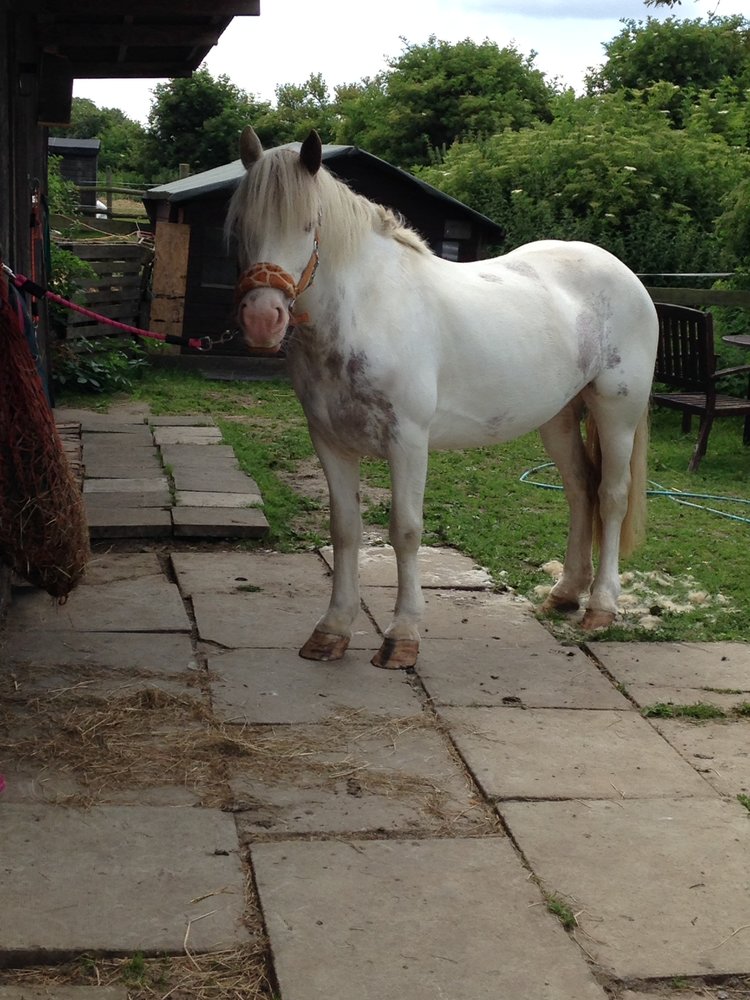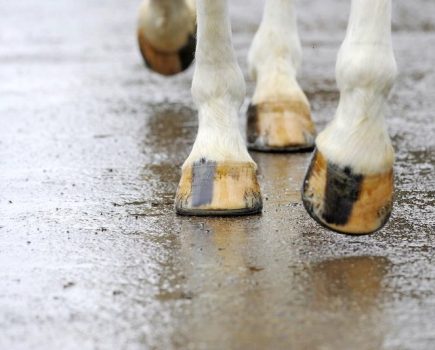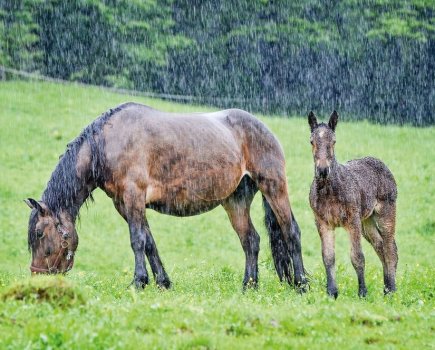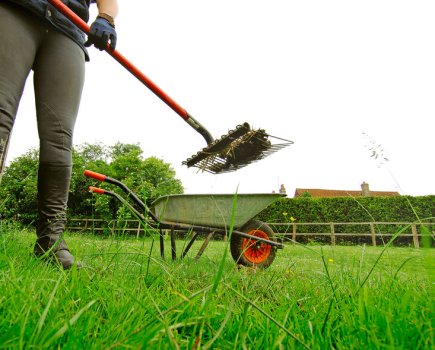Equine grass sickness is a condition that every horse owner dreads, as it often appears suddenly and in many cases proves fatal. Here, we meet three owners and their horses who, against the odds, have survived grass sickness.
Pete – or Petareta (pictured, top) as she’s more formally known – was found with two other horses roaming in a field earlier this year in a poor condition by Emma Pearson. After reporting the horses to the police and the World Horse Welfare, Emma ended up rehoming Pete at her yard in February.
Not long after Pete arrived, Emma began to notice that the mare was losing weight. Having lost a horse to grass sickness only a few days before, Emma feared the worst.
“I first noticed something was wrong with Pete when she started to drastically lose weight. She also seemed to take on a very tucked up look.
“When eating hay or haylage, she would dribble and have white foam at the mouth. After a week she eventually went off all forms of hay and hard feed, she didn’t drink any water for nearly two weeks, had a raised heart rate and just generally looked down and depressed. She spent a lot of her time lying down with little to no interest in anyone or her surroundings.
“After losing my Falabella just days before to subacute grass sickness, I knew in my gut that Pete had also come down with this dreaded illness. A visit from my vet sadly confirmed this.
“I spent the first three weeks living at the yard with Pete, just to make sure she would continue to eat. She would only eat if I sat in her stable next to her, so that’s how I spent my entire life for the first few weeks.
“I would spend hours going out picking her stinging nettles as she developed a taste for these. With my vet’s permission, I gradually began to take her out three times a day for short periods of in hand grazing and just to try and get her interested in something.
“Now, months later, my vets are really happy with the recovery and progress Pete has made. At one stage we thought we’d have to call it a day, she’s a fighter though and is still here.”
‘Mal being sick has totally changed my life’
 Mal’s owner Yvonne Maclean first noticed something wasn’t right when she tried to bring him in from the field to see the farrier.
Mal’s owner Yvonne Maclean first noticed something wasn’t right when she tried to bring him in from the field to see the farrier.
“He had his head down walking towards me and when he turned round, I knew instantly he had EGS. He was so tucked up, with his back legs right underneath him.
“He wouldn’t eat for the first three weeks, so we syringe fed him every hour. We got lots of feed samples to tempt him with and eventually he showed interested in a top-line conditioning mix. He loved it and is still on that feed now.
“We nursed him through the feeding issues, the sweating, the tremors and the lethargy for 14 weeks. Mal has such a stubborn streak and is such a strong-willed horse that I believe that’s what got him through.
“He never showed any signs of giving up, even when his weight dropped by over 150kgs. He went from 750kgs to 596kgs in the three weeks we were syringe feeding him. He got tired quickly, but he always showed signs of being happy to have me around.
“These days, it’s like a scene from Black Beauty every time he sees me at the gate. He is first over and normally galloping flat out towards you. He takes the huff if I go to the field to take one of the other horses out!
 “Nursing him through EGS was one of the hardest things I have ever done, but was also one of the most rewarding. I couldn’t have done it without my husband. He loves Mal to bits now and he has said that after going through it, he now can relate to how I feel about the horses, even though he’s not ‘horsey’.
“Nursing him through EGS was one of the hardest things I have ever done, but was also one of the most rewarding. I couldn’t have done it without my husband. He loves Mal to bits now and he has said that after going through it, he now can relate to how I feel about the horses, even though he’s not ‘horsey’.
“Mal being sick has totally changed my life. Last year to celebrate him surviving, I held a fun show where we raised £5731 for the Equine Grass Sickness Fund. We are currently organising the second event this year. The support we have received has been incredible and every year we remember all the horses and ponies lost to grass sickness with rosettes and trophies to help raise awareness.”
‘Mr V’s my miracle boy’
Hayley Cooper’s horse, Mr V, was first diagnosed with grass sickness in 2012, after she bought him in from the field in June to find him shivering.
 “The next morning he was still shaking, but tucked up all along the gutoral pouch. I rang the vet that night as he hadn’t eaten or drunk – they diagnosed over the phone that he had azoturia.
“The next morning he was still shaking, but tucked up all along the gutoral pouch. I rang the vet that night as he hadn’t eaten or drunk – they diagnosed over the phone that he had azoturia.
“I left it another 24 hours and he hadn’t eaten or drunk and was sweating on his neck, shoulder and had muscle tremors. The vet came out and took bloods, but these came back clear.
“The vet told me to monitor him for trouble swallowing, snuffly breathing and a snotty, dry scabby nose. I researched a paper at university on grass sickness a couple of years previous and, although it hadn’t been diagnosed, I knew that the vet suspected it.
“I started feeding as much as I could, but he wouldn’t eat hay or haylage, so he had racing mix and other high calorie feeds five to six times throughout the day.
“The next few weeks passed in a blur of trying to feed him, little in-hand walks and short bursts in the paddock with a friend to keep him stimulated. When he was left in the stable, he would almost go into a trance so I kept him busy!
“He lost so much weight that I couldn’t measure it with a weigh tape as it was just his ribs – I thought on numerous occasions that he was giving up, but right before I rang the vet he’d eat a bucket of food or be really happy!
 “I always said that if he didn’t prick up when I called his name, I’d call it a day. I thought nothing would ever change and then suddenly he started picking up – eating regularly and ever so slowly putting on weight and getting his shine back to his coat.
“I always said that if he didn’t prick up when I called his name, I’d call it a day. I thought nothing would ever change and then suddenly he started picking up – eating regularly and ever so slowly putting on weight and getting his shine back to his coat.
“He’s my miracle boy, but I do worry that his digestive system suffered a lot of damage and so always make sure he’s never without food!”
For more information about grass sickness, please visit www.grasssickness.org.uk









